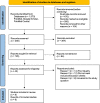The Progression of Chronic Myeloid Leukemia to Myeloid Sarcoma: A Systematic Review
- PMID: 35036234
- PMCID: PMC8752390
- DOI: 10.7759/cureus.21077
The Progression of Chronic Myeloid Leukemia to Myeloid Sarcoma: A Systematic Review
Abstract
Chronic myeloid leukemia (CML) is a slow-growing type of cancer that originates in the blood-forming cells of the bone marrow and is caused by a chromosomal mutation that is thought to occur spontaneously. CML could potentially lead to the development of myeloid sarcoma (MS), which is a rare neoplasm composed of immature myeloid cells that could evolve into a tumor mass at any anatomical site other than the bone marrow. MS can develop spontaneously or as a result of another form of myeloid neoplasm. Most instances of CML precede blast phase (BP) within two to three years after the first diagnosis of CML chronic phase (CP) at the age of pre-tyrosine kinase inhibitor (TKI) treatment. MS developing in CML patients during the era of TKI treatment is infrequently mentioned in the literature, primarily in single-case studies. As a result, the prognostic influence of MS in CML patients has not been well investigated. In the age of TKI treatment, it is uncertain whether MS and medullary BP have comparable clinical and prognostic relevance. The precise diagnosis of MS is critical for effective treatment, which is frequently delayed due to a high risk of misdiagnosis. This review focuses on the relationship between the development of MS from CML, and it culminates with recommendations for future hematology practice. A literature search was conducted in multiple databases, and the studies were appraised based on the inclusion and exclusion criteria. Finally, studies to date have shown that the existence of CML and its possible progression to MS in individuals map out the numerous implications this disease has in hematology practice. Though occurrences are uncommon in general, the prognosis for patients is bleak, necessitating the exploration and implementation of diagnostic and therapy advancements. Because there is limited evidence in the literature on its existence in the medullary chronic phase and outcomes in the era of TKI, it must be carefully investigated because it might be the first symptom of progressive illness prior to hematological progression.
Keywords: blastic crisis; chronic; chronic myeloid leukemia; disease progression; hematology; myeloid sarcoma.
Copyright © 2022, Arzoun et al.
Conflict of interest statement
The authors have declared that no competing interests exist.
Figures



References
-
- A discussion about the field of hematology/oncology. Crilley P, Baratam P. Oncol Times. 2019;41:16.
Publication types
LinkOut - more resources
Full Text Sources
Research Materials
Miscellaneous
